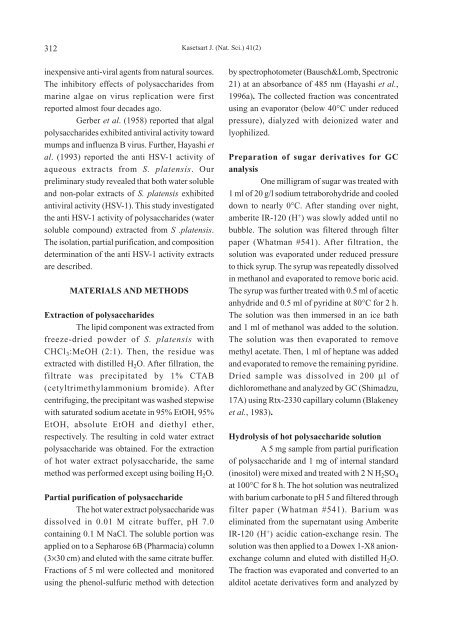April - June 2007 - Kasetsart University
April - June 2007 - Kasetsart University
April - June 2007 - Kasetsart University
You also want an ePaper? Increase the reach of your titles
YUMPU automatically turns print PDFs into web optimized ePapers that Google loves.
312<br />
inexpensive anti-viral agents from natural sources.<br />
The inhibitory effects of polysaccharides from<br />
marine algae on virus replication were first<br />
reported almost four decades ago.<br />
Gerber et al. (1958) reported that algal<br />
polysaccharides exhibited antiviral activity toward<br />
mumps and influenza B virus. Further, Hayashi et<br />
al. (1993) reported the anti HSV-1 activity of<br />
aqueous extracts from S. platensis. Our<br />
preliminary study revealed that both water soluble<br />
and non-polar extracts of S. platensis exhibited<br />
antiviral activity (HSV-1). This study investigated<br />
the anti HSV-1 activity of polysaccharides (water<br />
soluble compound) extracted from S .platensis.<br />
The isolation, partial purification, and composition<br />
determination of the anti HSV-1 activity extracts<br />
are described.<br />
MATERIALS AND METHODS<br />
Extraction of polysaccharides<br />
The lipid component was extracted from<br />
freeze-dried powder of S. platensis with<br />
CHCl 3:MeOH (2:1). Then, the residue was<br />
extracted with distilled H 2O. After fillration, the<br />
filtrate was precipitated by 1% CTAB<br />
(cetyltrimethylammonium bromide). After<br />
centrifuging, the precipitant was washed stepwise<br />
with saturated sodium acetate in 95% EtOH, 95%<br />
EtOH, absolute EtOH and diethyl ether,<br />
respectively. The resulting in cold water extract<br />
polysaccharide was obtained. For the extraction<br />
of hot water extract polysaccharide, the same<br />
method was performed except using boiling H 2O.<br />
Partial purification of polysaccharide<br />
The hot water extract polysaccharide was<br />
dissolved in 0.01 M citrate buffer, pH 7.0<br />
containing 0.1 M NaCl. The soluble portion was<br />
applied on to a Sepharose 6B (Pharmacia) column<br />
(3×30 cm) and eluted with the same citrate buffer.<br />
Fractions of 5 ml were collected and monitored<br />
using the phenol-sulfuric method with detection<br />
<strong>Kasetsart</strong> J. (Nat. Sci.) 41(2)<br />
by spectrophotometer (Bausch&Lomb, Spectronic<br />
21) at an absorbance of 485 nm (Hayashi et al.,<br />
1996a). The collected fraction was concentrated<br />
using an evaporator (below 40°C under reduced<br />
pressure), dialyzed with deionized water and<br />
lyophilized.<br />
Preparation of sugar derivatives for GC<br />
analysis<br />
One milligram of sugar was treated with<br />
1 ml of 20 g/l sodium tetraborohydride and cooled<br />
down to nearly 0°C. After standing over night,<br />
amberite IR-120 (H + ) was slowly added until no<br />
bubble. The solution was filtered through filter<br />
paper (Whatman #541). After filtration, the<br />
solution was evaporated under reduced pressure<br />
to thick syrup. The syrup was repeatedly dissolved<br />
in methanol and evaporated to remove boric acid.<br />
The syrup was further treated with 0.5 ml of acetic<br />
anhydride and 0.5 ml of pyridine at 80°C for 2 h.<br />
The solution was then immersed in an ice bath<br />
and 1 ml of methanol was added to the solution.<br />
The solution was then evaporated to remove<br />
methyl acetate. Then, 1 ml of heptane was added<br />
and evaporated to remove the remaining pyridine.<br />
Dried sample was dissolved in 200 µl of<br />
dichloromethane and analyzed by GC (Shimadzu,<br />
17A) using Rtx-2330 capillary column (Blakeney<br />
et al., 1983).<br />
Hydrolysis of hot polysaccharide solution<br />
A 5 mg sample from partial purification<br />
of polysaccharide and 1 mg of internal standard<br />
(inositol) were mixed and treated with 2 N H 2SO 4<br />
at 100°C for 8 h. The hot solution was neutralized<br />
with barium carbonate to pH 5 and filtered through<br />
filter paper (Whatman #541). Barium was<br />
eliminated from the supernatant using Amberite<br />
IR-120 (H + ) acidic cation-exchange resin. The<br />
solution was then applied to a Dowex 1-X8 anionexchange<br />
column and eluted with distilled H 2O.<br />
The fraction was evaporated and converted to an<br />
alditol acetate derivatives form and analyzed by
















